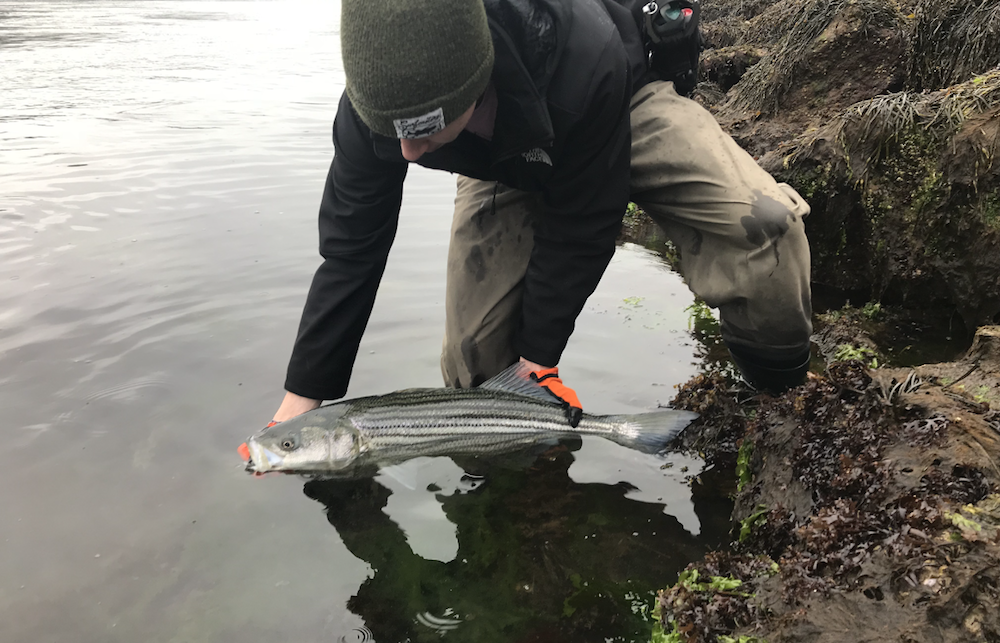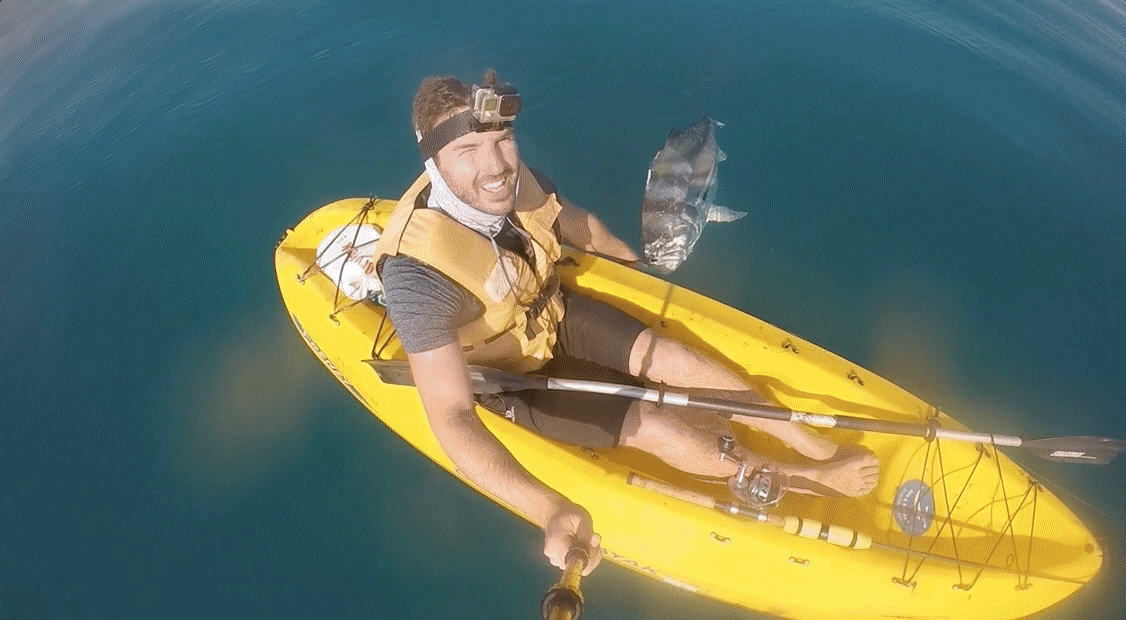
Ryan Collins
Research has shown that keeping fish in the water as much as possible goes a long way. Removing the fish from the water for a quick selfie photo can decrease the odds of its survival.
This year I'd like to promote a new initiative that I think we can all stand behind. I think the fish will benefit as well!
The objective of Keepemwet® is to the spread the word on the better handling of fish you are going to release. Keepemwet® is NOT in any way opposed to lawful harvest of fish for consumption. This is purely relevant to scenarios when fish are released.
More...
The Goal  To Increase The Odds of Survival
To Increase The Odds of Survival

Photo by burke_films
The Keepemwet® organization was started by Bryan Huskey, with some basic principles and tips for better handling of fish that you plan to release.
On their website, their mission statement reads that "Keepemwet® is about releasing fish in the best condition possible. It’s a motto for minimizing air exposure, eliminating contact with dry surfaces, and reducing handling.
It’s a movement to empower anglers to take small, simple steps to responsibly enjoy and share fishing experiences. the goal is to minimize the impact of catch & release angling on fisheries by uniting conscientious anglers, organizations and companies to promote science based practices for handling fish that are released."
Their main goals are to get anglers to
3 Keepemwet® Principles

Photo by keeganburke
1. Minimize Air Exposure
After reeling in your catch, chances are the fish has experienced some sort of exercise-induced stress, causing them to tire out and have diminished muscle function. For the fish to be able to recover from being caught, they need to stay in the water so they can breathe and pump oxygen into their system.
Keeping your fish out of the water can prevent recovery and may lead to death if done for too long. Even shorter durations (as little as 10-20 seconds for some species) can have serious effects on short-term and long-term fish health.
You can reduce these health effects by keeping a fish’s mouth and gills fully submerged in the water as much as possible during handling.

Photo by striper_swiper
2. Eliminate Contact with Dry Surfaces
That slime that covers a fish is actually a protective barrier for harmful bacteria and disease. Fish coming in contact with dry surfaces such as docks, boats, hands and grass can lose some of their protective barrier. Keepemwet® suggests the following steps:

3. Reduce Handling
The less time handling the fish, the better. Take some steps to prepare for your release by using barbless hooks. Make sure to have pliers and hook removal tools easily accessible, and if you are hoping for a photo, have someone ready to take the photo immediately.
Why This Should Matter To You
Lee Wulff famously said, "The finest gift you can give to any fisherman, is to put a good fish back." I will take that comment one step further by saying 
One thing we all have in common is the love of the catch. We wait all winter long to be a part of the great fish migrations that move through Cape Cod.
In order to keep these schools and migrations of fish healthy for years to come, we need to take care of this year's generation of fish first.
Throughout this season, please do your best to keep your fish wet! Take a selfie, but make it quick, and don't remove the fish from the water.
If we get enough people onboard with this mindset, it will help ensure we have healthy fish to catch in the future.
We can all make a huge difference in the strengthening of our fisheries by simply remember to keep the fish wet at all times.
Tight lines




I agree with respecting all fish. I hold my breath when taking a fish out of the water to remove the hook this way I know what it is feeling too. this is the way I gauge what is going on.
As I fish mostly fresh water, catch and release is the norm. “Do no harm” is the operative. De-barbed hooks, pliers and cameras are all at the ready. Great to see this initiative for larger salt water fish as well.
Thanks for the comment Ahvi, and keep up the good work ?
You are so helpful
You have every day something new
Keep going
We need more ??????????????????
My pleasure, thanks for reading ✌?
Along this thread is it right to have tournaments targeting undersized (schoolies) to try to catch the most total inches? There are a lot of talented and hopefully responsible fisherpersons that compete in these events but there will be a lot of fish caught and handled that otherwise would be left alone to grow. The fact that it is fly fishing only could lead to fish having to be played out longer if the gear isn’t matched to the fish.
I’m not against this but it seems like there could be way to have these get togethers without having a grand total be the winning factor.
Yep that is a good point Todd. ?
I do think many anglers are becoming more “enlightened” about good catch and release practices, and as a result I have a feeling a lot of the tournaments will be tweaking their rules to help the fish.
For example, I know the OTW Striper Cup has eliminated their weigh-in category, and is now all catch and release. I bet these tournaments will continue making improvements as anglers voice their concerns.
I whole heartily agree with this initiative. The time has come for us to do all we can to preserve the fish we admire.
Sounds great Bob, thanks for reading ??
Excellent article! It’s a reminder for all of us fishermen from novice to pro to exercise more caution on how we handle our catch in order to protect the future of our beloved sport. I’ve also been teaching my 7yr old grandson since he was 4 to always De-barb all our hooks. The 1st thing he reminds me of regardless of the lure is to “Papa, pinch the hooks!” Again, excellent article!
That’s awesome Ed! Your grandson sounds like quite the little fisherman! ?
I agree with this initiative and along with it we should all consider reducing the number of fish we catch and release during an outing. Safe handling procedures are great but it won’t mean as much and have the desired impact if we’re more interested in how many fish we catch rather than how we caught and released them. Just because we can catch and release a lot of fish doesn’t mean we should. That’s why I have always been a believer in slot limits. It invites anglers to limit their impact by taking one home for the table and then moving on, rather than staying in the same location catching and releasing higher number of fish several of which are going to die.
Well said Jeff, thank you ??
Thank you Ryan and others for supporting this effort. To the extent folks are willing to use crimped barbs and handheld hook detachers (easier to use with crimped barbs) – much less stressful and friendly to fish. Some of the one handed hook detachers are a 18-30” long so hopefully helps keep the hands a little further away from Whitey if in those waters. Trout fishing in West and MT, guides typically have rubberized nets, fish never leaves the water, and quick twitch with a hook detacher sends the trout back on its way without ever being touched. Thanks all!
Excellent insight Cal. Thank you! ??
We need to catch n release n police our own waters for the future of what we enjoy n love…Teach a man to fish n release wave for the future..Hookzup
??
Preaching to a preacher. Been passing the “don’t hold them vertically, keep them in the water, touch them as little as possible with wet hands for years. Get flustered every time I see one hanging from a Boga with a caption “released to swim another day”.
Thanks for passing along the info Dale ?
I think there is an unintended consequence (ie mortality) when we have minimum length requirements. Some will continue to fish until a keeper is landed. I often have wondered if minimum lengths have also reduced the number of fish in the spawning phase.
Yes that is certainly a plausible theory Jim. Thanks for commenting! ? Your comment is very similar to another point that a friend of mine brought up…
“Out west and up in British Columbia, steelhead fishermen/women take it a step further. If they catch a fish or two, they stop for the day…knowing that if they release 20-30 fish, they are likely killing 2-3 of those (I believe 10% mortality rate of released fish). I think anglers around here, just assume they are angels because they went out and released 50 schoolie stripers…when in reality, they might have just killed 5+ fish, far more than the guy that went out and caught one for dinner.”
I’m sure fishing guides out “west” limit their clients who have paid thousands of dollars for a “ trip of a lifetime” to two fish a day. Why don’t you also get rid of commercial fishing and get all the lure manufactures to sell lures that only have one circle hook instead of three trebles. You are preaching to the choir. This spring go to the canal and tell that to the fishermen there.
Hi there ?
Thanks for your comment.
With regards to commercial fishing, as mentioned in the third paragraph of this post, KEEPEMWET is not in any way opposed to the lawful harvest of fish for consumption. Everything mentioned in this post is purely relevant to scenarios when fish are released.
I’m sure not everyone out West is stopping after catching two or three steelhead. Some anglers are limiting themselves though. My friend heard about it in a podcast. I will try to get a link.
Replacing treble hooks with single hooks (even a circle hook) is worth experimenting with. For example, two weeks ago I was chasing around 50 pound roosterfish in Costa Rica in a small kayak. Replacing the treble hooks on my popper with one large circle hook made it much easier and quicker to release these incredibly powerful fish. It also made the experience much safer for me the angler, as I have put plenty of treble hooks in my hands over the years. Swapping out treble hooks may not make sense for every situation, but in certain situations it does make sense.
You are definitely correct about poor catch and release tactics at the canal. It’s very, very sad how some fish are treated down there. The good news is that a lot of people who fish the canal, have also read this post. I have heard from several already. Maybe the worst offenders have not read this post (and even if they did, they probably would not change) but some people improving their release tactics is better than no people. I myself after reading about KEEPEMWET, realize that I too could do a much better job releasing fish. For example, I would often lift fish far out of the water in order to get a good photo or video. I don’t plan on doing much of that during 2019. ✌?
Ryan, I completely agree that we have to protect our striper fishery. I’ve chased stripers with a fly rod since the early ninetys . I’ve been tying flies on barbless circle hooks since 2000. I’ve kept one fish in the last 5 years,only because I knew she wouldn’t survive. Using circle hooks hasn’t affected my catching fish at all,most are hooked in the corner of the mouth. Given that the ratio of eggs produced from a legal 28” keeper(about 100,000) to a 45” fish( about 4 million) a slot limit makes more sense. An 18” striper produces 2 serving sized filets. Larger fish provide more meat than I can use for one meal,leaving the rest to freeze. I I wanted frozen fish I would go to the supermarket. It would be cheaper than what I spend on fishing gear.Anything we can do to protect the striper fishery from a repeat of the devastating stock crash of the late seventy and early eighties is worth implimenting now.
Roger that, and sounds good ✌?Again thank you for your comment, and please keep in touch this season!
Excellent info. Ryan. I’ve always practiced catch & release. I will diffinetly be practicing and teaching this going forward.
tight lines
Dave
Sounds great Dave, thank you! ??
Great post. A lot to learn from their website.
thanks.
Agreed, they have some excellent best practice tips on this page too ?? https://www.keepemwet.org/tips#keepemwet-tips
I applaud all efforts to sustain this fishery for sports present and future. I do want to point out that holding the fish in the water can place yourself in danger. While fishing off Ptown last Summer I had a 3 foot striper boatside and as I grabbed the leader and was bending over to reach for the fish a huge mouth came straight up and slurped my fish like a sardine. That was closer to Whitey than I ever thought I would come. I recommend to all boat fisherpeople that they use a net to retrieve their catch! The boat next to us was kind enough to offer clean underwear!! I am all for releasing quickly, swapping your treble hooks for circle hooks and crimping the barbs, but be forwarned that keeping them wet could get you dead☠️
That is a crazy story Nick! Amazing how great white sharks are eating striped bass at boat side. Same thing happened to my father and I while reeling in a 30 pound striper, however our fish was eaten about 30 yards off the starboard side.
So yes, I think a rubberized net might be the best option when fishing in great white shark territory!
On another note, I will see you at the March Salties meeting!
I plan on promoting these strategies on my website fishingatwork.com . I read those reports about fish life expectancies after release and it is eye opening what has been happening if you don’t properly release fish.
Sounds great Dwight, thanks for passing along the info ?
I think this is great , I feel most anglers would go the extra yard if they knew how and the importantance of a proper release.
Way to go, on a side note. Getemwet tee shirts ???? I would buy one !!!!
I think so too Steve, and that tshirt idea is a good one!
Great !
We did a photo contest from the BBAC last year amongst other fishing Clubs showing release photos of fish still in the water. Keepemwet is a great movement and the word should be spread.
Ryan,
Can this article be shared to public ?
Yes Steve, it can be shared public ? Here is the link https://myfishingcapecod.com/keepemwet/
Keep up the good work with the BBAC!
Amen!
I’m a huge fan of catch and release. Much of my trout fishing is done in stocked ponds. Catch and release keeps catch ratios up, extends seasons, allows fish to grow larger and it controls costs. Keeping all fish in the water, trout especially, raises their recovery and survival rate substantially. Keep picture taking to a minimum. We’ll believe you. You’ll have a better memory without the picture because you’ll have burned the image into your brain.
Well said Kevin! ??
I’d like to add another point that a friend of mine just brought up…
“Out west and up in British Columbia, steelhead fishermen/women take it a step further. If they catch a fish or two, they stop for the day…knowing that if they release 20-30 fish, they are likely killing 2-3 of those (I believe 10% mortality rate of released fish). I think anglers around here, just assume they are angels because they went out and released 50 schoolie stripers…when in reality, they might have just killed 5+ fish, far more than the guy that went out and caught one for dinner.”
So maybe at least for striper fishing, catch and release, coupled with the mentality of stopping after you’ve caught enough, is probably a pretty good strategy to help the fishery.
Excellent info that should be utilized.
I have long been an advocate of catch -and – release,
both in fresh and saltwater fishing.
Thanks for supporting this effort!
No problem Ron, and thank you for reading! ??
I think it’s a great initiative. We have to protect our fish! And our natural resources! Great info, Thanks Ryan
My pleasure! ✌?I believe we will have more “enlightened” anglers this season, as more and more people discover why it’s so important to keep the fish wet.